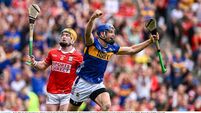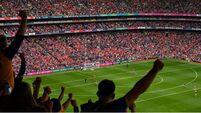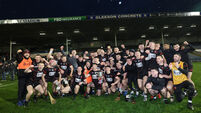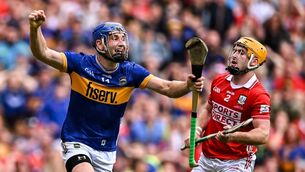Derek McGrath: Cork may have enough answers for Limerick's smiling assassins

Centre of attention: Limerick’s Cian Lynch is at the fulcrum of everything Limerick do. He will occupy a lot of the pre-game planning on the Cork side. Picture: James Crombie
“When patterns are broken new worlds emerge”
- Tuli Kupferberg
MANY column inches this week have been usurped by the Rebel revival. The last number of years have correctly focused on the redeveloped academy and underage development influence of the Joe McKenna-led Limerick initiative.
People can learn from winning templates and adapt to suit the idiosyncrasies of their own county. While many have rightly pointed to the visionary approach of Kevin O’Donovan and the progressive commercialisation and investment of ‘One Cork’, the progress has been balanced nicely with a real sense of authenticity and awareness of the importance of the club and volunteers.
What hasn’t been noted is the influence, probing, highlighting and collaborative outside-the-box thinking that the likes of Noel Furlong, Donal Og, Kieran Murphy, Pat Ryan and Donal O’Mahony have had on the overall vision.
Forgotten at times is the once scapegoated players of the ‘strike era’ whose vision of what was needed for a high-performance environment to flourish is now being realised. It might not be popular to say it but these were men ahead of their time who knew what was required to thrive.
They will inwardly be smiling now.
Such willingness to change has also made its way to Cork’s playing style too. It was interesting to hear Shane McGrath remark this week that Tipperary will have to “change the way they play” to suit the modern game. Thankfully for Cork, this realisation differs greatly from the “flying by the seat of your pants” approach which was evident at times over the last number of years.
Ahead of the league final of 2015, Waterford had decided to play with Colin Dunford simply as a third midfielder, locating him in front but not marking Tadgh de Burca’s man, Seamie Harnedy. The plan was to counter-attack with huge intent and runners off the shoulder while at the same time clogging both Harnedy’s and Lehane’s space to operate. Amazingly Cork followed Colin out the pitch and we were left with two-on-two inside all day.
When we met in the Championship some five weeks later, we changed it up and decided to use two extra midfielders. Surely Cork would not follow out but incredibly they did, leaving Maurice one-on-one onside. This tactical inflexibility has now been replaced with more detailed planning whilst still allowing the team to play to their strengths.
Players and management would have clearly realised the scrutiny that goes with this change and have controlled the media message well on the role of Mark Coleman by using such terms as 6.5 or ‘plus 1’ or ‘sitting 6’.
The “we’re a young team” maxim has been cleverly managed and ensures expectations are controlled. Kieran Kingston spent the winter planning. He made some tough calls. He looked for and recruited help. Crucially he managed to change the tactical structure of the team while bringing the Cork people with him. Even the omission of his own son for the semi-final, while based on form, presented to the Cork people with a sense this is a man who puts Cork before everything.
Watching Donal O’Grady roguishly chat with referee Aodhan Mac Suibhne ahead of the 2004 All-Ireland final, I was struck when I learned afterwards that he was, in fact, checking the possibility of Diarmuid O’Sullivan pucking the ball out to the Cloyne netminder.
These are the marginal gains. I used always try to provide the sliotar to the referee for a game and would try the quick handpass to him and see if there was any reaction questioning the legitimacy of the fast action, sometimes even dropping the line “that’s a perfect handpass isn’t it?”
This ‘innocence’ was evident as Limerick awaited the return of Waterford to the field for the semi-final second half two weeks ago. Cian Lynch chatted openly to James Keenan followed by a smiling and questioning Gearóid Hegarty before the camera clipped to the two assassins, Gillane and Flanagan, engaging in light-hearted banter with the tickled umpires.
Smiling is great when you are eight points up and is a character trait of the Limerick team. Take the iconic clip of Sean Finn and Cian Lynch joking ahead of the 2018 final and one gets a sense of a team with the bigger picture in mind — but with the ruthless recognition when the task is on.
The involvement of Donal O’Grady will have added to the meticulous Cork planning that is necessary to challenge the Limerick way. Allied to this has been the more controlled approach of Diarmuid O’Sullivan this year too. With all this positivity, however, the key will lie in whether they are far enough down the line to take down the champions. Detail will define them.
“You must envision the future deeply and in detail, creatively so that the unforeseeable becomes foreseeable. Then you write your script for the foreseeable”
- Bill Walsh from ‘The Score Takes Care of Itself’.
Within the depth of scripting and planning, Kieran Kingston rightly pointed this week to the room that still has to be allowed for gut/instinctive decisions to be made. The presence of flexibility, creativity and adaptability will be crucial on Sunday.
Cork will have dissected Waterford’s approach to the first quarter against Limerick and will have noted (as Jamie Barron did) that if Waterford’s scoring efficiency was better, a five-point lead would not have flattered the Déise.
They will also have looked in depth at the tactical approach of Waterford. Despite lazy criticism of Liam Cahill’s decision to play Shane Bennett as a sweeper, this was effectively what Waterford did against Tipperary the week before and was the approach espoused by all experts prior to the game. The crucial learning for Cork, however, should lie in Limerick’s ability to play around a sitting 6. Limerick’s numbers game allied to the presence of two of Gillane, Casey, and Flanagan inside essentially means that they can make the cover look lost at times.
So much of Cork’s approach would depend on the availability or not of Ger Millerick. If he plays, Cork can mirror their early approach to the Kilkenny game and particularly TJ Reid. Cork’s approach underlined their new found flexibility. Coleman basically manned the D from a wing back position as opposed to centre back. The same conundrum now applies to Cian Lynch.
Lynch dealt brilliantly with the man-marking capabilities of Dan McCormack and Conor Gleeson and if Millerick’s likely replacement is detailed on Gearoid Hegarty based on his excellent physical approach to the hurler of the year in the drawn Munster 2018 championship game, the puzzle becomes harder to solve. The simple question of marking Lynch but allowing Coleman hoover and set up play will have been the greatest source of debate for the Cork brains trust.
In the semi final, when Millerick was at 6 man-marking TJ, Coleman ignored John Donnelly and left him to the hunting pack of Cahalane, Robbie O Flynn, Meade, and Fitzgibbon.
Cork will have assessed the numbers. Lynch dominated McCormack, dominated Gleeson so maybe it’s time to leave, in Millerick’s likely absence, an initial grey area around one of the greatest hurlers of his generation — in other words, Eoin Cadogan goes toe to toe with Hegarty and tries to win the physical and aerial battle. Coleman hoovers, sweeps and occasionally gets forward to both set up attacks and pop the odd score whilst Lynch becomes the property of the pack.
The dilemma with the other wing match-up is equally important. I have returned on several occasions to Waterford’s approach in the Munster final last year and the Cork management will surely have analysed the Déise approach. Tim O’Mahony, if matched with Tom Morrissey, would also be well advised to mix his attacking approach with a Diarmuid Byrnes type zonal reading. This will invariably cut down the possibility of that cross-field diagonal ball to Gillane which Ronan Maher successfully did in the Munster final and Calum Lyons and Tadgh de Burca did last year at the same juncture.
To allow clarity with this plan, the double jobbing influence of Cahalane, Meade, and O’Flynn — with perhaps Jack O’Connor and Kingston making sporadic bursts outfield leaving Horgan alone — can be productive for the Rebels.
Kieran has to play Shane from the start with the likely impact of Shane Barrett and Alan Cadogan bringing an element of surprise. He will also hope for an end-of-season return to form from the brilliant Darragh Fitzgibbon. The early message will surely be to Meade to hold whilst Fitzgibbon’s instructions will be to break that tackle, put that ball on the hurley and GO.
Limerick’s approach will be equally fascinating. Data may drive their approach to work rate and targets but equally, they may make subtle tweaks to their tactical approach. To date, they’ve used Peter Casey as the ‘wanderer’ from the full-forward line, the genial Na Piarsaigh player using his creativity and guile to both score and set up chances.
However, in some big games in the past, Kiely and Kinnerk have assigned that wandering role to Flanagan. Whilst aware of his red hot form inside, Limerick may well have considered Niall O’Leary’s comfort bursting forward from those advanced areas and may want Sean O’Donoghue in that pursuing mode, and not O’Leary. Remember Shane Kingston’s goal in the earlier Munster Championship game was the direct result of an O’Leary burst forward.
I don’t subscribe to the theory that it’s simply a battle of Cork’s speed against Limerick’s advanced physicality and that Limerick can choke the life from anyone in the middle third.
Cork need the opportunity to stretch their legs and Limerick will seek to ensure they are deep enough not to allow that to happen. Witness Will O’Donoghue hunting down Jamie Barron and Gillane hounding Shane Bennett in the semi-final. Witness Hegarty cascading away from speedster Calum Lyons in the semi-final and one quickly appreciates the speed contest might not be as straight-forward as perceived.
With 18 minutes to go in the All Ireland of 2017, we crept into a one-point lead and our running game began to take shape. Once the Galway subs began to wrest the momentum back, we began lumping balls into the square showing the inexperience of infrequent All-Ireland contenders.
Cork will need to remain true to their running game, remain true to their give-and-gos while mixing in measured deliveries to Hoggie. But they’ll need to think a lot and think fast. Mercedes Benz CEO Dieter Zetsche once said: “If you walk at a certain speed, you stay where you are. So you’d better run. You have to adapt. It’s not about reinvention, it’s about finding the solutions quicker than others.”
I think Cork can find them on Sunday.

Subscribe to access all of the Irish Examiner.
Try unlimited access from only €1.50 a week
Already a subscriber? Sign in









